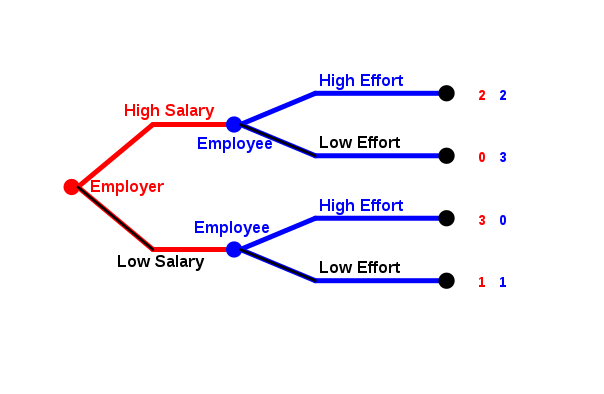Gift-exchange game
The gift-exchange game is a game that has been introduced by Akerlof and Yellen as standard for modeling labor relations.[1] Two players are at least involved in such game – an employee and an employer. The employer has to decide first, whether to award a higher salary. Then, the decision of the employee about putting extra effort follows. Like trust games, gift-exchange games are used to study reciprocity for human subject research in social psychology and economics.[2] If the employer pays extra salary and the employee puts extra effort, then both players are better off than otherwise. The relationship between an investor and an investee has been investigated as the same type of a game.[3]

Equilibrium analysis
The extra effort in gift-exchange games is modeled to be a negative payoff if not compensated by salary. The IKEA effect of own extra work is not considered in the payoff structure of this game. Therefore, this model rather fits labor conditions, which are less meaningful for the employees.[4][5]
Like in trust games, game-theoretic solution for rational players predicts that employees’ effort will be minimum for one-shot and finitely repeated interactions. Therefore, there is no incentive for the employer to pay a higher salary.[1][2][6] If the employer pays a higher salary, it is irrational for the employee to put extra effort, since effort will reduce his or her payoff. It is also irrational for the employee to put extra effort while receiving a lower salary. Therefore, the minimum salary and the minimum effort is the equilibrium of this game.
The payoff matrix of the gift-exchange game has the same structure as the payoff matrix of Prisoner's dilemma. The difference constitutes by the sequentiality of gift-exchange game.[7]
Experimental results
A positive relationship between salary and effort has been observed in a large number of gift-exchange experiments.[8][9][10] This behavior obviously deviates from the equilibrium. In a game of one employer and one employee, an experiment on 84 undergraduate students from the University of Amsterdam showed a rate of only 23.8% of employee's minimal effort for high salary.[11] Another experiment with students from Tilburg University showed that only 33% of games ended up in the Nash equilibrium with minimal salary and minimal effort.[12] Data from another experiment on 123 students from University of Nottingham showed a rate of 69% for high salary being paid by employer in advance.[13][5]
See also
- Trust game
- Prisoner's dilemma
- Ultimatum game
- Efficiency wage
References
- Akerloff, A. G.; Yellen, J. (1990). "The fair wage-effort hypothesis and unemployment". Quarterly Journal of Economics. 105: 255–283.
- Fehr, E.; Gächter, S. (1990). "Fairness and Retaliation: The Economics of Reciprocity". The Journal of Economic Perspectives. 14: 159--181.
- Berg, Joyce; Dickhaut, John; McCabe, Kevin (July 1995). "Trust, Reciprocity, and Social History". Games and Economic Behavior. 10 (1): 122–142. doi:10.1006/game.1995.1027.
- Ariely, Dan; Kamenica, Emir; Prelec, Dražen (September 2008). "Man's search for meaning: The case of Legos". Journal of Economic Behavior & Organization. 67 (3–4): 671–677. doi:10.1016/j.jebo.2008.01.004. hdl:10161/6324.
- Tagiew, Rustam; Ignatov, Dmitry (2016). "Gift Ratios in Laboratory Experiments" (PDF). CEUR Workshop Proceedings. Vol-1627 (Experimental Economics and Machine Learning): 82--93.
- Charness, Gary; Cobo-Reyes, Ramón; Jiménez, Natalia; Lacomba, Juan A; Lagos, Francisco (August 2012). "The Hidden Advantage of Delegation: Pareto Improvements in a Gift Exchange Game". American Economic Review. 102 (5): 2358–2379. doi:10.1257/aer.102.5.2358.
- Charness, Gary; Frechette, Guillaume R.; Kagel, John H. (June 2004). "How Robust is Laboratory Gift Exchange?". Experimental Economics. 7 (2): 189–205. doi:10.1023/B:EXEC.0000026979.14590.3c.
- Fehr, E.; Kirchsteiger, G.; Riedl, A. (1 May 1993). "Does Fairness Prevent Market Clearing? An Experimental Investigation". The Quarterly Journal of Economics. 108 (2): 437–459. doi:10.2307/2118338.
- Fehr, Ernst; Gächter, Simon (May 1998). "Reciprocity and economics: The economic implications of Homo Reciprocans". European Economic Review. 42 (3–5): 845–859. doi:10.1016/S0014-2921(97)00131-1.
- Charness, Gary (July 2004). "Attribution and Reciprocity in an Experimental Labor Market". Journal of Labor Economics. 22 (3): 665–688. doi:10.1086/383111.
- Maximiano, Sandra; Sloof, Randolph; Sonnemans, Joep (July 2007). "Gift Exchange in a Multi‐Worker Firm". The Economic Journal. 117 (522): 1025–1050. doi:10.1111/j.1468-0297.2007.02065.x.
- Heijden, ECM; Nelissen, JHM; Potters, JJM; Verbon, HAA (26 March 2007). "Simple and complex gift exchange in the laboratory". Economic Inquiry. 39 (2): 280–297. doi:10.1111/j.1465-7295.2001.tb00066.x.
- Gächter, Simon; Nosenzo, Daniele; Sefton, Martin (December 2012). "The Impact of Social Comparisons on Reciprocity*". The Scandinavian Journal of Economics. 114 (4): 1346–1367. doi:10.1111/j.1467-9442.2012.01730.x.